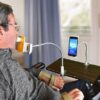Shares of Medpace Holdings, Inc. (NASDAQ: MEDP) jumped more than 50 per cent in pre-market trading after the company posted strong Q2 2025 results and raised its full-year guidance.
On Tuesday, shares surged to around USD$477.73, up from a prior close of USD$308.88.
Medpace delivered a standout Q2, with revenue rising 14.2 per cent year-over-year to USD$603.3 million. This beat analyst expectations of USD$538.77 million and surpassed the 9.3 per cent growth recorded in Q1 2025. Despite a challenging biotech funding climate, the company’s momentum clearly accelerated.
Earnings per share reached USD$3.10, topping the consensus estimate of USD$2.99 and improving from USD$2.75 a year earlier. Net income rose to USD$90.3 million on a GAAP basis, reflecting stronger operational efficiency and cost discipline. Notably, the earnings before interest and taxes (EBIT) margin held firm at 22.3 per cent, highlighting consistent profitability—a key driver of investor confidence.
Importantly, Medpace raised its full-year 2025 revenue guidance for the second time this year. The company now projects between USD$2.42 billion and USD$2.52 billion, up from the previous range of USD$2.14 billion to USD$2.24 billion. It also increased its GAAP net income outlook to between USD$405.0 million and USD$428.0 million. That translates to EPS of USD$13.76 to USD$14.53, compared to prior guidance of USD$12.26 to USD$13.04.
This guidance hike reinforced investor optimism. Medpace reported USD$620.5 million in new business awards in Q2, improving its net book-to-bill ratio. That momentum helped restore confidence after a 19 per cent drop in net new bookings in Q1 triggered an 11.2 per cent stock decline.
Read more: Breath Diagnostics leader speaks at lung cancer education event in Louisville
Read more: Breath Diagnostics takes aim at lung cancer with One Breath
Investors have reacted positively
Operational efficiency and targeted acquisitions further boosted sentiment. Medpace continues to outperform by focusing on small- and mid-sized clients in the biotech, pharmaceutical, and medical device sectors. Since Q2 2016, revenue has grown a staggering 495.26 per cent through Q3 2024.
Despite earlier project cancellations across the sector, Q2 results suggest Medpace may be turning a corner. The company’s ability to grow revenue by 14 per cent while preserving strong EBITDA margins highlights its leadership in the CRO space.
Investors also reacted positively to Medpace’s USD$518 million share buyback program, which signaled management’s confidence in long-term value creation. During intraday trading on July 22, shares spiked as much as 53.6 per cent.
Still, some analysts remain cautious. The average price target sits at USD$302.12, implying a 2.19 per cent downside from the prior close. While short-term enthusiasm is high, Medpace must maintain operational momentum to support its valuation.
Analyst sentiment remains mixed. As of May 27, 2025, 14 analysts rated the stock a “Buy,” while 4 recommended holding. No sell ratings were issued. However, firms like William Blair and TD Cowen downgraded Medpace to “Market Perform” and “Hold” in April, citing demand uncertainty and growing competition.
The broader market backdrop adds complexity. On July 11, 2025, the S&P 500 and Nasdaq dropped following President Donald Trump’s 35 per cent tariff on Canadian imports. However, Medpace appears insulated from these trade pressures, as its services face minimal exposure to such policy shifts.
Read more: Breath Diagnostics opens Respiratory Innovation Summit with captivating presentation
Read more: Breath Diagnostics now offering a compelling investment opportunity
OneBreath offers promise for early cancer detection
Beyond financial metrics and CRO sector dynamics, investors are also eyeing innovation in medical technology devices. This adjacent space continues to drive investor interest, particularly as healthcare shifts toward non-invasive diagnostics and portable treatment options. Companies leading in breath-based diagnostics and respiratory support technologies are gaining traction.
For example, Breath Diagnostics Inc. has developed a non-invasive device that analyzes volatile organic compounds in exhaled breath. Its OneBreath technology shows promise for early cancer detection, especially lung and esophageal cancers. The device aims to deliver faster, cost-effective diagnoses without the need for invasive biopsies. Therefore, its potential to integrate into primary care workflows has drawn attention from both researchers and investors.
Additionally, Breath Diagnostics aligns with trends toward decentralized care and point-of-need solutions. These trends mirror larger shifts in healthcare delivery, particularly post-pandemic. As clinical trials increasingly rely on remote monitoring and decentralized models, demand grows for versatile diagnostic and treatment tools.
Medpace’s involvement with clinical development across diverse indications could position it as a partner to such innovators. CROs that integrate cutting-edge devices into trials will likely gain a competitive edge. Therefore, watching how Medpace collaborates—or competes—with med-tech disruptors could offer further insight into its long-term strategy.














